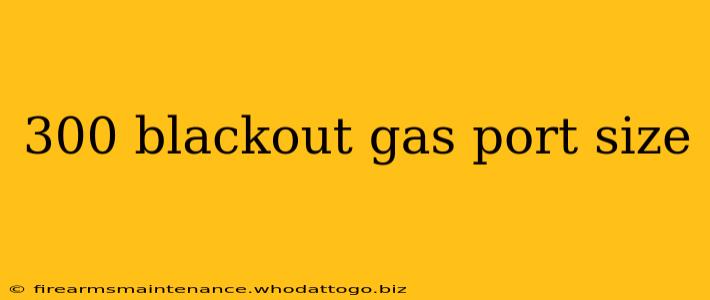The gas port size on a 300 Blackout AR-15 is a critical factor influencing its reliability and performance. Getting it right is essential for consistent cycling and optimal function, regardless of whether you're using subsonic or supersonic ammunition. This guide will delve into the nuances of 300 Blackout gas port sizing, helping you understand the implications of various sizes and how to choose the right one for your build.
Understanding Gas Port Function
Before we dive into specific sizes, let's clarify the gas port's role. The gas port is a small hole drilled into the barrel, located just ahead of the gas block. When a round is fired, a small amount of propellant gas is diverted through this port. This gas then travels into the gas tube, impacting the gas key and operating rod, ultimately cycling the action and allowing for the next round to be chambered. The size of this port directly dictates how much gas is diverted, and consequently, how effectively the action cycles.
Common 300 Blackout Gas Port Sizes
Several gas port sizes are commonly used in 300 Blackout barrels, each with its own set of advantages and disadvantages. These are usually measured in thousandths of an inch. You'll often see sizes like:
- 0.070": This is a popular choice for many users, offering a good balance between reliability with both subsonic and supersonic ammunition.
- 0.075": Slightly larger than 0.070", this size is often preferred for those using heavier subsonic loads or those experiencing cycling issues with a smaller port size. It provides more gas to the system.
- 0.0625": A smaller port size, sometimes found in barrels optimized for supersonic ammunition. It may require more precise tuning and might have reliability issues with subsonic rounds.
Note: The optimal gas port size can also depend on other factors such as barrel length, gas block type (low-profile, adjustable), and the specific ammunition used.
Choosing the Right Gas Port Size
The selection process is nuanced and isn't a simple "one size fits all" approach. Consider these key factors:
1. Ammunition Type:
- Supersonic: Generally, smaller gas ports work well with supersonic ammunition. These rounds produce higher pressure, requiring less gas to cycle the action reliably.
- Subsonic: Subsonic rounds generally produce lower pressure, often requiring larger gas ports to ensure reliable cycling.
2. Barrel Length:
Shorter barrels tend to need larger gas ports due to less time for gas pressure to build before it reaches the gas block. Longer barrels often work well with smaller ports.
3. Gas Block Type:
Adjustable gas blocks offer the ability to fine-tune the gas flow, mitigating the need for perfectly sized gas ports. They're a great option for experimenting with different ammo types.
Troubleshooting Gas Port Issues
If you encounter cycling problems, it could be related to the gas port size. Symptoms might include:
- Failure to cycle: This could indicate insufficient gas. Consider increasing the gas port size (if feasible) or using an adjustable gas block.
- Excessive recoil or over-gassing: This might point to an oversized gas port. Reducing the size might be necessary, although this often requires professional gunsmithing.
Conclusion
Selecting the appropriate 300 Blackout gas port size requires careful consideration of ammunition type, barrel length, and gas block type. While a 0.070" gas port is a common starting point, experimentation or professional guidance may be necessary to achieve optimal performance and reliability with your specific setup. Remember, always prioritize safety and seek the assistance of a qualified gunsmith if you are unsure about modifying your firearm.

